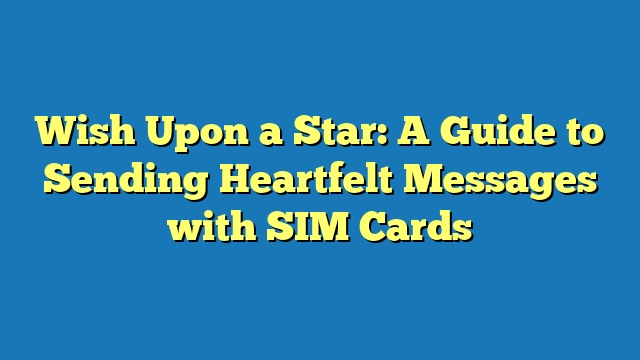SIM card messages, also known as SMS messages, are text-based messages sent and received via cellular networks. The messages are typically limited to 160 characters and are stored on the SIM card, which is a small, removable chip inserted into a mobile phone.
SIM card messages are a convenient way to communicate with others, especially when data or Wi-Fi is not available. They are also useful for sending short updates or reminders to groups of people. The first SMS message was sent in 1992 and the technology has since become ubiquitous around the world.
This article will explore the various uses, benefits, and limitations of SIM card messages. We will also discuss the history of SMS and its impact on modern communication.
What Are SIM Card Messages?
SIM card messages, also known as SMS messages, are a crucial part of mobile communication. They offer a convenient and efficient way to send and receive text-based messages, even when data or Wi-Fi is not available.
- Conciseness
- Accessibility
- Cost-effectiveness
- Versatility
- Security
- Reliability
- Global reach
- Historical significance
- Integration with other technologies
- Future potential
The key aspects of SIM card messages extend beyond their basic functionality. They have played a significant role in shaping communication patterns, bridging distances, and facilitating various forms of mobile interaction. From enabling emergency communication to supporting business transactions, SIM card messages continue to evolve and adapt to the changing landscape of technology and communication.
Conciseness
Conciseness is a defining characteristic of SIM card messages. They are designed to convey information in a brief and succinct manner, adhering to the 160-character limit. This attribute makes them particularly suitable for quick updates, reminders, and essential communications.
-
Character Limit
The 160-character limit imposes a discipline of brevity, encouraging users to convey their message in a clear and concise way.
-
Reduced Misinterpretation
Concise messages are less prone to misinterpretation, as they eliminate unnecessary details and focus on the core message.
-
Efficient Communication
Conciseness facilitates efficient communication, allowing users to quickly convey their message without overwhelming the recipient with excessive information.
-
Cost-Effectiveness
In some cases, mobile carriers charge based on the number of characters in a message. Conciseness can therefore result in cost savings.
The conciseness of SIM card messages not only enhances their practicality but also contributes to their widespread adoption as a reliable and efficient means of communication.
Accessibility
Accessibility is a defining aspect of SIM card messages that significantly contributes to their widespread adoption and usage. The accessibility of SIM card messages stems from the ubiquity of mobile phones and the ease with which they can be used to send and receive messages.
SIM card messages can be sent and received on virtually any mobile phone, regardless of the make, model, or operating system. This cross-platform compatibility ensures that users can communicate with each other seamlessly, irrespective of their device preferences. Additionally, SIM card messages are not dependent on data or Wi-Fi connectivity, making them accessible even in remote or underserved areas where internet access is limited.
The accessibility of SIM card messages has far-reaching implications. It enables individuals to stay connected with friends, family, and colleagues, regardless of their location or device. It also plays a crucial role in emergency situations, allowing people to send and receive important updates and information even when other forms of communication are unavailable.
Cost-effectiveness
Cost-effectiveness is a significant advantage of SIM card messages. They offer a cost-effective way to communicate compared to other forms of messaging, such as voice calls or data-based messaging applications.
One of the key reasons for the cost-effectiveness of SIM card messages is their use of a dedicated network for message transmission. This network is separate from the data network used for internet access, which means that sending and receiving SIM card messages does not incur data charges. Additionally, many mobile carriers offer bundled plans that include a certain number of free or discounted SIM card messages, further reducing the cost of communication.
The cost-effectiveness of SIM card messages is particularly beneficial in developing countries and remote areas, where data connectivity may be limited or expensive. In these regions, SIM card messages remain a reliable and affordable way for individuals to stay connected and share information.
Overall, the cost-effectiveness of SIM card messages makes them a valuable tool for individuals and businesses alike. They provide a reliable and cost-efficient way to communicate, facilitating conversations, sharing information, and staying connected.
Versatility
The versatility of SIM card messages is a key factor contributing to their widespread adoption and continued relevance in the mobile communication landscape. SIM card messages offer a diverse range of capabilities that extend beyond basic text-based communication, making them suitable for a variety of purposes.
-
Cross-Platform Compatibility
SIM card messages can be sent and received across different mobile devices and operating systems, fostering seamless communication between users regardless of their device preferences or technical limitations.
-
Integration with Multimedia
SIM card messages support the integration of multimedia content, allowing users to send and receive images, videos, and audio files, enhancing the richness and expressiveness of communication.
-
Integration with Applications
SIM card messages can be integrated with various mobile applications, enabling users to receive updates, notifications, and alerts directly on their mobile devices, providing convenience and real-time access to information.
-
Use in Machine-to-Machine Communication
SIM card messages play a crucial role in machine-to-machine (M2M) communication, facilitating the exchange of data between devices, sensors, and other machines, enabling automation and remote monitoring applications.
The versatility of SIM card messages extends their utility beyond interpersonal communication, making them valuable tools for businesses, organizations, and individuals alike. They enable efficient information dissemination, remote device management, and the creation of innovative mobile solutions, contributing to the overall growth and advancement of the mobile communication ecosystem.
Security
Security plays a crucial role in the realm of SIM card messages. The sensitive nature of personal and private information transmitted through SIM card messages demands robust security mechanisms to protect against unauthorized access and misuse.
One of the key security features of SIM card messages is the use of encryption. Encryption involves scrambling the message content using a secret key, making it unreadable to anyone who does not possess the key. This ensures the confidentiality and integrity of the message, preventing eavesdropping and tampering during transmission.
SIM cards themselves also incorporate physical security measures to protect against unauthorized access. These measures may include tamper-proof packaging, secure element chips, and PIN codes, which act as a second layer of authentication to prevent unauthorized use of the SIM card.
The security features embedded in SIM card messages provide peace of mind to users, ensuring that their private communications remain confidential and protected from malicious actors. This trust and reliability are essential for the widespread adoption and continued use of SIM card messages as a secure and convenient communication channel.
Reliability
Reliability is a critical component of what are sim card messages. SIM card messages are a reliable form of communication because they are not dependent on data or Wi-Fi connectivity. This means that they can be sent and received even in areas with poor or no internet access. Additionally, SIM card messages are stored on the SIM card itself, which makes them less susceptible to loss or damage than messages that are stored on a phone’s internal memory.
The reliability of SIM card messages makes them an ideal choice for important communications, such as emergency alerts, appointment reminders, and financial transactions. They can also be used to send and receive messages in areas where data or Wi-Fi is not available, such as in remote locations or during power outages.
In conclusion, the reliability of SIM card messages makes them a valuable tool for communication. They are a reliable way to send and receive important messages, even in areas with poor or no internet access.
Global reach
SIM card messages have achieved global reach, transcending geographical boundaries and cultural differences to become a ubiquitous form of communication. This widespread adoption is attributed to several factors that highlight the essential role of SIM card messages in connecting people worldwide.
One key factor driving the global reach of SIM card messages is their accessibility. SIM card messages can be sent and received on any mobile phone, regardless of the make, model, or operating system. This cross-platform compatibility ensures that users can communicate seamlessly, fostering global connectivity and bridging communication gaps.
Another factor contributing to the global reach of SIM card messages is their cost-effectiveness. In many regions, sending and receiving SIM card messages is relatively inexpensive, making them an affordable communication option for people across socio-economic strata. This affordability has played a significant role in the widespread adoption of SIM card messages, particularly in developing countries where access to other forms of communication may be limited.
The global reach of SIM card messages has had a profound impact on communication patterns and social interactions. It has facilitated communication between people from different cultures and backgrounds, promoting understanding and breaking down barriers. SIM card messages have also played a crucial role in disaster relief efforts, enabling coordination and communication in areas where other infrastructure may be damaged or unavailable.
In conclusion, the global reach of SIM card messages is a testament to their versatility, accessibility, and cost-effectiveness. These factors have combined to make SIM card messages a truly global communication tool, connecting people across borders and enabling them to share information, stay connected, and navigate the challenges of an increasingly interconnected world.
Historical significance
The historical significance of SIM card messages lies in their role as a transformative technology that has revolutionized mobile communication and shaped the way we connect with each other. From their humble beginnings to their widespread adoption and continued evolution, SIM card messages have left an indelible mark on the landscape of telecommunications.
-
Pioneering innovation
SIM card messages, first introduced in the 1990s, represented a groundbreaking advancement in mobile communication. They enabled users to send and receive text-based messages, a capability that was previously unavailable on mobile phones.
-
Global connectivity
The widespread adoption of SIM card messages fostered global connectivity, allowing people across borders and cultures to communicate seamlessly. This played a pivotal role in bridging distances and facilitating cross-cultural exchange.
-
Communication in times of crisis
SIM card messages have proven invaluable during emergencies and natural disasters. Their reliability and accessibility have enabled people to stay connected and share vital information in situations where other forms of communication may be disrupted.
-
Foundation for mobile applications
The success of SIM card messages laid the foundation for the development of mobile applications and services. The ability to send and receive messages on mobile phones opened up new possibilities for information dissemination, entertainment, and social networking.
In conclusion, the historical significance of SIM card messages stems from their role as a pioneering innovation that revolutionized mobile communication. They have fostered global connectivity, provided a lifeline during emergencies, and paved the way for the development of a vast ecosystem of mobile applications and services. Their impact continues to shape the way we communicate and interact in the digital age.
Integration with other technologies
The integration of SIM card messages with other technologies has been a driving force behind their continued relevance and widespread adoption. By leveraging the capabilities of various technologies, SIM card messages have evolved into a versatile and powerful communication tool.
One significant integration is with mobile applications. Many apps, such as social media platforms and messaging services, have incorporated the ability to send and receive SIM card messages directly within their interfaces. This integration provides users with a seamless and convenient way to communicate, regardless of the app they are using. For example, users can send text messages to their contacts directly from within a social media app, eliminating the need to switch between different applications.
Another key integration is with mobile payment systems. SIM card messages play a crucial role in facilitating mobile payments, particularly in regions where contactless payment infrastructure is less developed. By sending a simple text message to a designated number, users can initiate and complete financial transactions securely and conveniently. This integration has significantly expanded the reach of mobile payments, making it more accessible to a broader population.
In conclusion, the integration of SIM card messages with other technologies has greatly enhanced their functionality and usability. By leveraging the capabilities of mobile applications, payment systems, and other technologies, SIM card messages have become an indispensable part of the mobile communication ecosystem. This integration has not only improved the user experience but has also expanded the scope of applications for SIM card messages, making them a truly versatile and powerful communication tool.
Future potential
The future potential of SIM card messages is vast and promising, with advancements in technology expected to further enhance their capabilities and applications. As mobile technology continues to evolve, SIM card messages are likely to remain a critical component of the mobile communication ecosystem, offering a reliable and versatile channel for communication.
One area of future development is the integration of SIM card messages with artificial intelligence (AI) and machine learning algorithms. This integration could enable SIM card messages to become more intelligent and personalized, with the ability to filter and prioritize messages, provide automated responses, and even offer proactive suggestions based on user preferences and behavior. For example, a user could set up their SIM card to automatically send a response to incoming messages while they are driving, or to provide reminders and updates based on their location or calendar events.
Another area of future development is the use of SIM card messages for secure and convenient mobile payments. By leveraging the unique security features of SIM cards, mobile payments could become even more secure and accessible. For example, SIM card-based mobile payments could be used to make purchases in physical stores, pay for public transportation, or send money to friends and family. This could significantly reduce the need for cash and traditional payment methods, making transactions more convenient and efficient.
In conclusion, the future potential of SIM card messages is limited only by our imagination. As technology continues to advance, we can expect to see even more innovative and groundbreaking applications for this versatile and powerful communication tool. SIM card messages have the potential to not only enhance our ability to communicate but also to transform the way we interact with the world around us.
FAQs about SIM Card Messages
This section addresses frequently asked questions about SIM card messages, providing clear and concise answers to common queries and misconceptions.
Question 1: What exactly are SIM card messages?
Answer: SIM card messages, also known as SMS messages, are text-based messages sent and received via cellular networks. They are stored on the SIM card, a small removable chip inserted into a mobile phone.
Question 2: What are the benefits of using SIM card messages?
Answer: SIM card messages offer several advantages, including their accessibility, cost-effectiveness, versatility, security, reliability, and global reach.
Question 3: What are some of the limitations of SIM card messages?
Answer: One limitation of SIM card messages is their character limit, which restricts the length of messages to a maximum of 160 characters.
Question 4: How can I send and receive SIM card messages?
Answer: To send and receive SIM card messages, you will need a mobile phone with a SIM card inserted. You can compose and send messages using the built-in messaging app on your phone.
Question 5: Are SIM card messages secure?
Answer: Yes, SIM card messages are generally considered secure. They utilize encryption and other security measures to protect the privacy and confidentiality of your messages.
Question 6: What is the future of SIM card messages?
Answer: The future of SIM card messages looks promising, with advancements in technology expected to further enhance their capabilities and applications.
In summary, SIM card messages remain a valuable and widely used communication tool. Their unique combination of features and benefits makes them suitable for a diverse range of purposes.
Transition to the next section: To delve deeper into the technical aspects of SIM card messages, let’s explore their underlying technology and network infrastructure.
Tips to Enhance Your SIM Card Message Experience
This section provides practical tips to optimize your use of SIM card messages, ensuring effective and seamless communication.
Tip 1: Utilize Abbreviations and Acronyms
Shorten frequently used words or phrases to save characters and convey more information within the 160-character limit.
Tip 2: Split Long Messages
If your message exceeds the character limit, break it into multiple messages to ensure proper delivery and avoid confusion.
Tip 3: Use Clear and Concise Language
Be mindful of your word choices and avoid jargon or slang to ensure clarity and prevent misinterpretation.
Tip 4: Proofread Before Sending
Take a moment to review your message for any errors in grammar, spelling, or factual information before sending it.
Tip 5: Store Important Messages
Save significant or sentimental SIM card messages in a designated folder or note-taking app for easy retrieval in the future.
Tip 6: Utilize Multimedia Features
Where available, incorporate images, videos, or audio clips into your SIM card messages to enhance their expressiveness and impact.
Tip 7: Manage Your SIM Card Storage
Regularly check the storage capacity of your SIM card and delete old or unnecessary messages to avoid exceeding its limit.
Tip 8: Protect Your SIM Card
Keep your SIM card safe from physical damage or unauthorized access by storing it in a secure location and using a PIN code for additional protection.
By following these tips, you can optimize your use of SIM card messages, ensuring effective communication, efficient use of character limits, and overall message clarity.
Transition to the conclusion: These practical tips empower you to harness the full potential of SIM card messages, enabling seamless and impactful communication in various personal and professional contexts.
Conclusion
This comprehensive exploration of “what are SIM card messages” has shed light on the multifaceted nature and significance of this communication channel. SIM card messages have evolved from their humble beginnings as text-based messages to become versatile tools that facilitate a wide range of communication needs.
Throughout the article, we have highlighted several key points:
- SIM card messages offer a unique combination of accessibility, affordability, reliability, and global reach, making them a valuable communication tool for individuals and organizations alike.
- The integration of SIM card messages with other technologies, such as mobile applications and payment systems, has greatly expanded their functionality and usability.
- The future of SIM card messages holds exciting possibilities, with advancements in AI and mobile payment systems expected to further enhance their capabilities and applications.
In conclusion, SIM card messages continue to play a vital role in our communication landscape. Their versatility, adaptability, and potential for future growth make them an essential tool for navigating the ever-evolving world of mobile communication.









Tips for Using "Template by Kevin Crafts" Comments for Meaningful Online Discussions